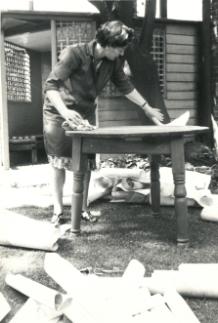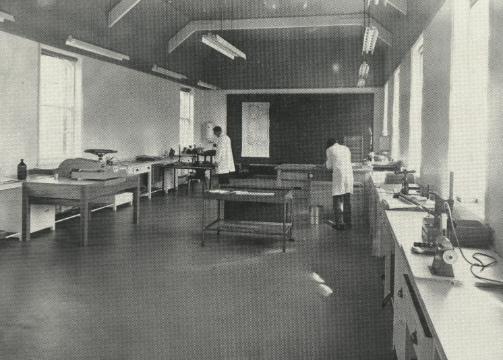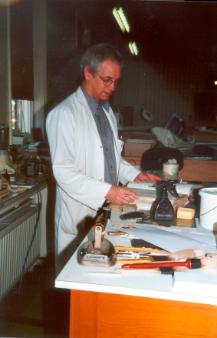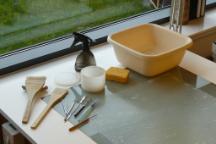How has our archive conservation developed?

Norah Gurney, Archivist, cleaning
glebe terriers in the Borthwick
garden, 1960s
Archive conservation has developed out of all recognition during the last six decades.
In 1953, conservation was in its infancy and it was not unusual for a record office like the Borthwick to begin without a 'document repairer' (as conservators were then called).
In the earliest years Borthwick archivists did some basic repair and cleaning and some work was sent out to private repairers.
The first archive assistant, appointed in 1953, was sent to the Public Record Office for training so he could carry out some of the more urgent repairs to documents, and in 1957 some 'bookbinding material and equipment' were acquired so that basic repairs to manuscript volumes could be done.
In the early 1960s the Borthwick records clerk was created a 'technical assistant' and he took courses in repair and photography.
However, with demands for copies of documents increasing, photography soon took over almost completely from repair and in 1964 he was transferred to the new University Library as the new University Photographer.
With problems of conservation becoming more urgent, in December 1964 the first dedicated document repairer was finally appointed and he was sent to the Public Record Office for his training.
"The appointment of a full-time repairer, Mr D. Willis, at the end of 1964, was long overdue; there is an immense accumulation of work waiting for his attention. Much of this is so urgent that some sections cannot be listed, let alone used by readers, until the documents are repaired.
Some groups of the archives, notably the terriers and cause papers, are in urgent need of fumigation as outbreaks of mould have been discovered. Among the terriers the growth was probably caused by their having been left rolled in brown paper. In other sections the ventilation of the strong room is suspect. The lack of space for expansion resulted in storage being extended to the top of the shelving, thus impeding the circulation of air. A close watch is now being kept and constant temperature and humidity checks are made…
A considerable improvement has already been effected in many groups of documents and it is obvious that the Institute's archives will benefit greatly from Mr Willis's skill and the enthusiasm he has for his work."
Borthwick Institute Annual Report 1965
Within a year it was noted that the document repairer had become 'a most valuable member of the staff'. More equipment had been installed and the Borthwick was already sharing this new expertise by agreeing with the City Council that the repairer would repair some seals on city charters.

The new conservation room, 1970
The 'repair room' was initially very small and cramped (it doubled as a tea room!) but in 1970, after the Borthwick had expanded into a further section of St Anthony's Hall, a new dedicated conservation room was opened.
This allowed greater space and storage and the installation of new equipment such as a laminating press, large repair bench, a wall board for map repair, drying racks and a drying cupboard.
In 1967 the Borthwick's new searchroom assistant was almost immediately given training so he could give some assistance to the repairer.

Conservator at work, 2000
This arrangement was so successful that in 1972 he was made a full time assistant repairer and in due course succeeded as Borthwick Conservator.
Numbers of Borthwick conservation staff have fluctuated from one to two (currently two), supplemented at various times by project staff. Conservators have always been relatively few in number within the City and county, so the conservation department has regularly done work for other bodies: for example, in the 1970s - 1990s work was being done for York City Archives, Hull University Library, the Brotherton Library and York Minster Library.
One unusual example of work for other bodies came in 1990 when the Borthwick Conservator was responsible for the cleaning and conservation of 'The King's Book of York Heroes': a large volume, weighing over nine stones, recording the names, portraits and details about the 1,167 local men and women who died in the First World War. The volume is in the care of the Dean and Chapter of York and its conservation was funded by York Civic Trust.
Mr Trevor Cooper, Borthwick Conservator 1981 - 2009, was awarded the MBE for services to conservation in 1999.
The York City House Books
The Borthwick's conservators have often pioneered new conservation techniques. A notable example of this was the project, in partnership with York City Council, to conserve the York City House Books from the York City Archives. These had been repaired in the early 20th century, after damage from a disastrous flood, using a semi-permeable and very acid tissue-type paper pasted to the pages with an unknown adhesive, probably composed of flour paste and animal glue. With the passage of time the tissue had become very dark brown and increasingly opaque, obscuring the writing underneath. This massive conservation project began in 1982 and continued into the 1990s. Advice was initially taken from Mr A.D. Baynes-Cope, formerly of the British Museum Research Department, but after some volumes proved resistant to more conventional methods, the Borthwick conservators decided, after consulting the University Biology Department, to use enzymes for removal of the adhesive - a very new method originally pioneered by Mrs Judy Segal, conservator at the Bodeleian Library, Oxford. This project proved a great success, not just because it saved the City House Books but also because it added much to the stock of conservation knowledge.
Training for Conservators
The need for conservation training has always been very important for the Borthwick. In 1973, the Borthwick's conservator was awarded an instructor's certificate under the new Society of Archivists' conservation training scheme, and during the 1970s and 1980s a number of conservators from elsewhere came to the Borthwick for training in all aspects of archive conservation. Since the 1980s the Borthwick has concentrated on in-house conservation training: every one of the Borthwick conservators has been trained by his/her immediate predecessor. The Borthwick aims to resume its national training role, as a centre of parchment instruction, in the near future.
How has conservation changed since the Borthwick appointed its first document repairer? The problems mentioned in 1965 are all still key concerns in the workshop today, and reflect that the needs of the documents remain the same: appropriate packaging, suitable storage environment and safe access. The 'immense accumulation of work' is still being faced, and the number of archives in need of remedial treatment is still great. Conservators must have a variety of necessary skills, including the expertise and understanding to physically stabilise archives that are unfit for production.
Conservator's bench and tools today
The tools and equipment that were used in the workshop in 1965 are still being used, but developments in materials, equipment and science have created more options for treatment. There is a remarkable range of repair papers and tissues to choose from, and a greater variety of materials such as consolidants and adhesives are also readily available. Equipment that was once constructed in-house by the conservators, such as leaf casters, fume cupboards and suction tables, are now commercially available, often on a much larger scale. Developments such as these influence the techniques that are used within the workshop, offering conservators more choices when confronted by vulnerable archives.


